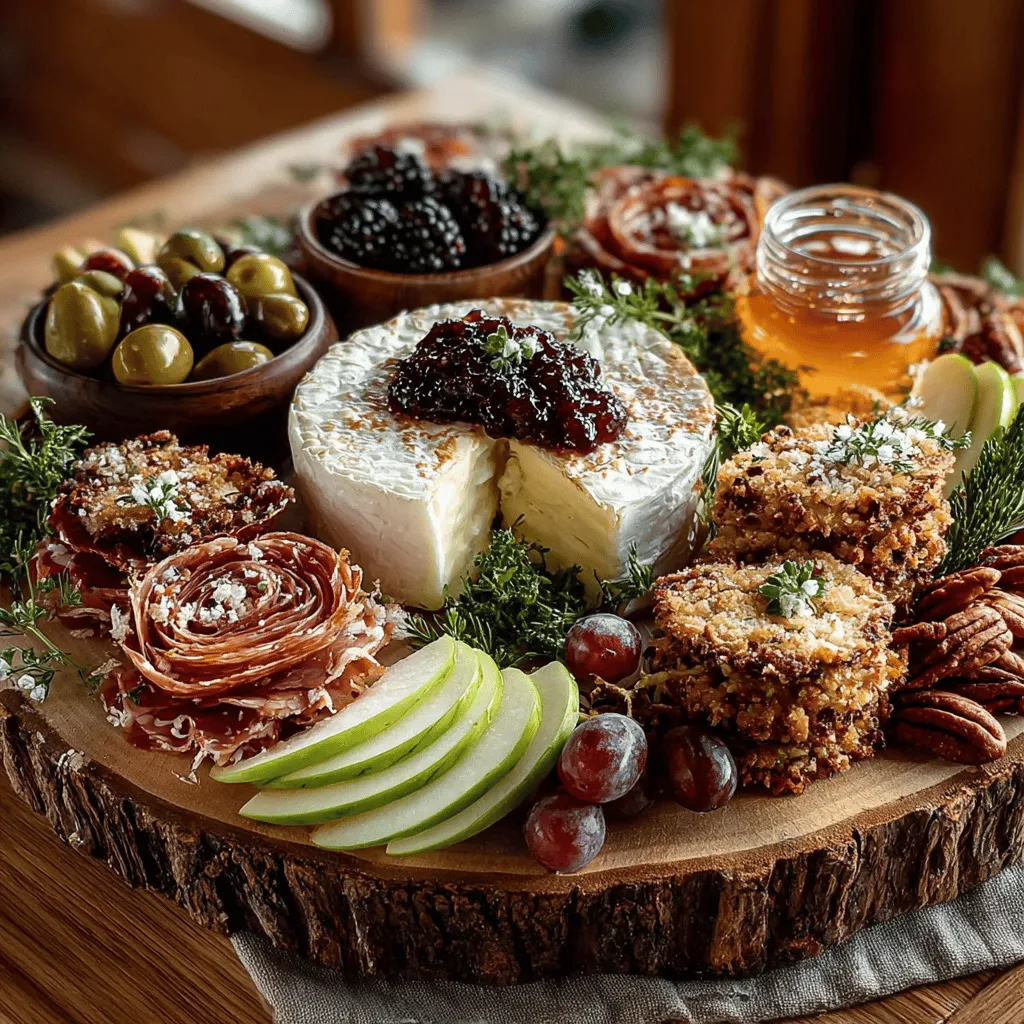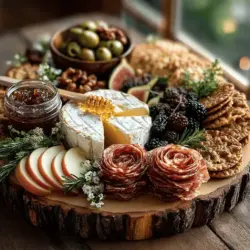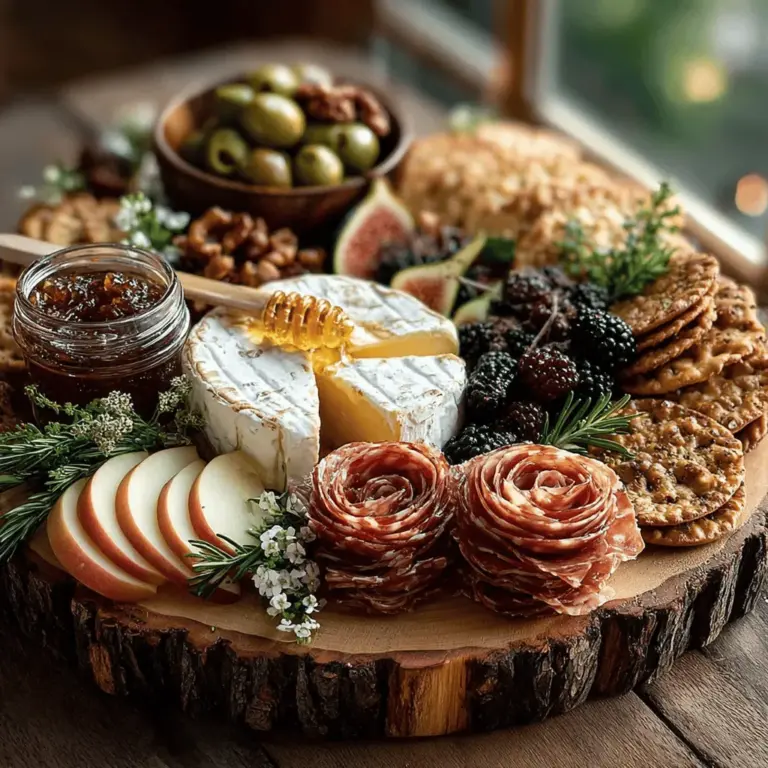Introduction
In recent years, charcuterie boards have transformed from a simple selection of meats and cheeses into an artful centerpiece synonymous with gatherings, celebrations, and even relaxed evenings at home. Their vibrant array of cured meats, artisanal cheeses, and colorful accompaniments creates an inviting atmosphere that not only encourages sharing but also sparks delightful conversations among guests. Whether you’re hosting a holiday party, a casual get-together, or simply indulging in a cozy night with loved ones, a charcuterie board can elevate any occasion. This guide will take you through the steps to create a stunning charcuterie board, highlighting the delightful flavors of Brie cheese, savory meats, and an assortment of fresh fruits and nuts.
Understanding the Charcuterie Board Concept
Definition and History of Charcuterie
Charcuterie, a French term that translates to “cooked meat,” originally referred to the art of preparing various meat products. Dating back to ancient times, this culinary tradition was developed as a way to preserve meats through curing, smoking, and salting. The craft of charcuterie was particularly prominent among French butchers, who specialized in creating a variety of meat products, from pâtés and terrines to sausages and cured hams.
Over the years, the concept of charcuterie has evolved to encompass a broader selection of food items, moving beyond just meat to include cheeses, fruits, nuts, and condiments. The modern charcuterie board is a celebration of flavors, textures, and colors, making it a visually appealing and gastronomically satisfying experience. As social gatherings became more relaxed and informal, the charcuterie board emerged as a perfect solution, allowing guests to graze and mingle while enjoying an exquisite array of tastes.
The Rise in Popularity in Modern Entertaining
The charcuterie board has seen a significant rise in popularity in recent years, fueled by the social media boom and the desire for aesthetically pleasing food presentations. Instagram and Pinterest have played a vital role in showcasing creative charcuterie designs, inspiring home hosts to experiment and personalize their boards. This trend reflects a shift toward more interactive dining experiences, where guests can customize their plates and engage in the art of sharing.
In addition to their visual appeal, charcuterie boards also offer versatility. They can be tailored to suit various dietary preferences, from vegetarian and vegan options to gluten-free selections, making them suitable for any gathering. As a result, they have become a go-to choice for parties, picnics, and even intimate dinners, serving as a culinary canvas for hosts to express their creativity.
Choosing the Perfect Base for Your Board
Selecting the Right Board
The foundation of any charcuterie board is the board itself. Selecting the right base not only enhances the presentation but also influences the overall experience. Here are some considerations to keep in mind when choosing a board:
Types of Boards: Wood vs. Marble
1. Wooden Boards: Wooden boards are a popular choice for charcuterie due to their warmth and rustic charm. They offer a natural aesthetic that complements the organic look of the ingredients. Various types of wood, such as acacia, bamboo, or walnut, can be used, each lending its unique character to the board. Wooden boards are also excellent for serving cold items, as they retain their temperature well.
2. Marble Boards: For a more sophisticated and elegant look, marble boards are an outstanding option. They provide a sleek surface that contrasts beautifully with the vibrant colors of meats and cheeses. Marble has the added benefit of being cool to the touch, which can help keep items like cheeses at the ideal serving temperature. However, marble is heavier and can be more challenging to clean than wood.
Size Considerations Based on the Number of Servings
When selecting a board, size matters. The dimensions of your board should reflect the number of guests you plan to serve. For smaller gatherings, a 16-inch board may suffice, while larger events may require a board that is 24 inches or more. If you are uncertain about the size, consider using multiple smaller boards to create a visually dynamic display. This approach allows for easier handling and can add variety to your presentation.
Highlighting the Star Ingredient: Brie Cheese
The Allure of Brie
No charcuterie board is complete without a selection of cheeses, and Brie stands out as a fan-favorite. This soft cheese, originating from the Brie region of France, is celebrated for its creamy texture and rich, buttery flavor. The cheese is encased in a delicate white rind, which is both edible and adds a subtle earthiness to the overall taste experience.
Brie’s appeal lies not only in its flavor but also in its versatility. It pairs beautifully with various accompaniments, from sweet to savory, making it an essential ingredient for any charcuterie board. Guests can enjoy it spread on crackers, paired with fruits, or even drizzled with honey for a touch of sweetness.
Tips for Selecting the Best Brie
When shopping for Brie, consider the following tips to ensure you choose the best quality:
1. Check the Rind: The rind should be firm but not overly hard, indicating that the cheese is fresh. A creamy, slightly pliable texture within suggests optimal ripeness.
2. Observe the Color: Look for a white rind with no discoloration or dark spots. The cheese itself should have a pale yellow hue and appear smooth.
3. Smell the Cheese: A fresh Brie will emit a mild, pleasant aroma. If the cheese has an overwhelming odor or smells sour, it may be past its prime.
Crafting the Meat Component
The Role of Meats in a Charcuterie Board
Meats are a central component of any charcuterie board, adding depth and variety to the flavor profile. The inclusion of cured meats not only enhances the visual appeal but also provides a contrast to the creaminess of cheeses like Brie. Popular options for a charcuterie board include prosciutto, salami, and chorizo, each contributing its distinct taste and texture.
1. Prosciutto: This Italian dry-cured ham is known for its delicate, sweet flavor and melt-in-your-mouth texture. Its thinly sliced nature allows it to be easily wrapped around fruits or vegetables, making it a versatile addition.
2. Salami: Salami comes in various styles and flavors, from spicy to smoky. Its robust taste pairs well with cheeses and can be arranged in overlapping slices or rolled into pinwheels for an eye-catching presentation.
3. Chorizo: This Spanish sausage, typically seasoned with paprika, adds a spicy kick to the board. Its vibrant red color can brighten the overall display and offers a bold contrast to milder cheeses.
Tips for Presentation: Folding and Layering Techniques
How you present your meats can significantly impact the visual appeal of your charcuterie board. Here are some techniques to enhance the presentation:
– Folding: Instead of laying the slices flat, try folding them in half or creating small stacks. This technique adds height and dimension to the board.
– Layering: Arrange the meats in groups, allowing for variety in colors and textures. Mixing different types of meats can create an inviting display that encourages guests to explore different flavor combinations.
Incorporating Nutty Texture
The Importance of Mixed Nuts
Nuts are an essential component of a charcuterie board, providing a satisfying crunch that complements the softer textures of cheeses and meats. They also introduce an additional layer of flavor, with options ranging from salty to sweet. Including a selection of mixed nuts can enhance the overall experience, offering guests a chance to nibble on something different.
Nutritional Benefits of Nuts
Beyond their delicious taste and texture, nuts are packed with nutrients. They are an excellent source of healthy fats, protein, and essential vitamins and minerals. Incorporating nuts into your charcuterie board not only adds variety but also contributes to a more balanced snacking experience.
How to Choose and Arrange Nuts for Visual Appeal
When selecting nuts for your board, consider a mix of different types, such as almonds, walnuts, pecans, and cashews. Aim for a balance of flavors, including both salted and unsalted options. For visual appeal, consider using a small bowl or ramekin to contain the nuts, preventing them from rolling around the board. Alternatively, scatter them in small piles across the board to create a more organic look.
Adding Freshness with Fruits
Fresh fruits bring a burst of color and sweetness to your charcuterie board, balancing the richness of cheeses and meats. Consider incorporating a variety of fruits, such as grapes, figs, berries, and apple slices, to create a vibrant display. Not only do these fruits enhance the visual appeal, but they also provide refreshing notes that cleanse the palate between bites.
As you assemble your Dreamy Charcuterie Board, keep in mind the art of balance. Aim for a harmonious blend of flavors, textures, and colors, ensuring that each component complements the others. With careful selection and presentation, your charcuterie board will not only be a feast for the senses but also a delightful conversation starter for any gathering.

The Significance of Fresh Fruits
Fresh fruits play a pivotal role in any charcuterie board, adding vibrant colors, juicy textures, and a refreshing contrast to the savory elements. Not only do they enhance the visual appeal of your board, but they also contribute essential flavors that balance the richness of cheeses and meats.
Best Fruits for Charcuterie Boards
When selecting fruits for your charcuterie board, consider incorporating a variety of options that offer different tastes and textures. Here are some top choices:
– Grapes: Their natural sweetness and crisp texture make grapes a classic addition. Opt for a mix of red and green varieties for visual contrast.
– Figs: Fresh or dried figs provide a unique flavor profile with their sweet, honey-like taste. They pair wonderfully with creamy cheeses and cured meats.
– Apples: Crisp apple slices add a refreshing crunch. Choose varieties like Granny Smith for tartness or Honeycrisp for sweetness.
How to Cut and Arrange Fruits for Aesthetic and Flavor Balance
To maximize the impact of your fruits on the charcuterie board, consider the following preparation and arrangement tips:
– Cutting: Slice apples into wedges with the skin on for a rustic look. Halve figs to reveal their beautiful interior, and leave grapes on the stem for a more natural presentation.
– Arrangement: Strategically place fruit around the board to create visual balance. For instance, cluster grapes in one corner, scatter apple slices throughout, and nestle figs near creamy cheeses. This not only enhances aesthetics but also ensures that guests can easily access a variety of flavors.
The Salty Contrast: Olives
Olives bring a delightful salty contrast to the savory and sweet components of your charcuterie board, making them an essential addition.
Why Olives Are Essential
Olives are not only flavorful but also add a sophisticated touch to your board. Their briny taste complements cheeses and meats beautifully, enhancing the overall flavor experience.
Types of Olives to Include and Their Flavor Profiles
Consider including a selection of olives to provide variety:
– Kalamata Olives: These dark purple olives have a rich, fruity flavor with a hint of bitterness, making them perfect for pairing with tangy cheeses.
– Green Olives: Briny and firm, green olives offer a crisp bite that contrasts nicely with creamy cheeses.
– Castelvetrano Olives: Known for their sweet and mild flavor, these olives are a crowd favorite and can be a great starting point for those new to olives.
Creative Presentation Ideas for Olives
To make olives visually appealing, you can:
– Use Small Bowls: Serve olives in small, decorative bowls to keep them contained and add height to your board.
– Garnish with Herbs: Toss olives with fresh herbs like rosemary or thyme to enhance flavor and aesthetics.
The Crunch Factor: Assorted Crackers
The right selection of crackers can elevate your charcuterie board, providing essential crunch and texture that complements the other elements.
Choosing the Right Crackers
When selecting crackers, consider pairing options that enhance the flavors of your cheeses and meats:
– Water Crackers: These are neutral in flavor, making them perfect for allowing the cheese to shine.
– Whole Grain Crackers: With their nutty flavor and hearty texture, whole grain crackers pair beautifully with rich cheeses.
– Flavored Crackers: Look for herb-infused or cheese-flavored crackers to add extra depth to your board.
Arrangement Tips for a Visually Appealing Display
To create an eye-catching arrangement with your crackers:
– Variety in Shape and Size: Use a mix of round, square, and rectangular crackers to add visual interest.
– Layering: Create height by stacking some crackers or leaning them against the side of the board. This not only looks appealing but also makes it easier for guests to serve themselves.
Sweet Accents to Balance Flavors
Sweet components such as honey and fig jam play a vital role in balancing the savory elements of your charcuterie board.
The Role of Honey and Fig Jam
– Honey: Drizzling honey over cheese not only adds sweetness but also enhances the cheese’s flavor. It’s particularly delicious with blue cheese or goat cheese.
– Fig Jam: This sweet spread pairs well with salty meats and tangy cheeses, creating a delightful contrast. A dollop of fig jam next to cheese can elevate the entire tasting experience.
Presentation Ideas for Sweet Components
To showcase your sweet accents:
– Use Small Jars: Serve honey and fig jam in small glass jars or bowls. This not only keeps things tidy but also adds a rustic charm to your board.
– Labeling: Consider using small labels to identify each sweet component, helping guests to easily choose their favorites.
Garnishing Your Board with Fresh Herbs and Flowers
Garnishing your charcuterie board with fresh herbs and edible flowers can elevate its visual appeal while adding subtle flavors.
The Art of Garnishing
Choosing the right herbs and flowers can enhance both the aesthetics and taste of your board:
– Choosing Herbs for Flavor and Aesthetics: Fresh herbs like rosemary, thyme, and basil can be artfully placed around the board. Their vibrant colors and aromatic presence will entice your guests.
– The Impact of Edible Flowers on Presentation: Edible flowers, such as nasturtiums or pansies, add a pop of color and a touch of elegance. Sprinkle a few around the board to create a stunning visual impact.
Creating a Welcoming Atmosphere for Serving
Setting the scene for your charcuterie board is just as important as its creation. A warm and inviting atmosphere encourages guests to relax and enjoy the experience.
Tips for Serving: Cheese Knives, Small Plates, and Utensils
– Cheese Knives: Provide a selection of cheese knives for different cheese textures. A soft cheese knife, a hard cheese knife, and a spreader will ensure your guests can easily serve themselves.
– Small Plates and Utensils: Offer small plates and forks or toothpicks to facilitate sharing. This encourages guests to mingle and try different combinations from the board.
Encouraging Interaction and Sharing Among Guests
To foster a sense of community:
– Seating Arrangement: Arrange seating around the charcuterie board to encourage conversation. This invites guests to gather around and share their favorite pairings.
– Interactive Elements: Consider incorporating a DIY element, such as allowing guests to assemble their own mini bites using the available ingredients. This adds a fun and engaging aspect to the experience.
Conclusion
A beautifully arranged charcuterie board not only pleases the palate but also elevates any gathering into a memorable experience. By following the steps outlined in this guide, you can create a dreamy charcuterie board that showcases a delightful balance of flavors, textures, and colors. Whether for a festive celebration or a casual get-together, your guests will appreciate the thoughtfulness and creativity behind your culinary masterpiece. Enjoy the process of assembling and sharing your creation, and relish the joy it brings to your gatherings.

